Comparison of the Utilization of 110 °C and 120 °C Heat Sources in a Geothermal Energy System Using Organic Rankine Cycle (ORC) with R245fa, R123, and Mixed-Ratio Fluids as Working Fluids
Abstract
1. Introduction
2. Thermodynamic Modeling
3. Experimental and Equipment Setup
3.1. Heat Cycle
3.2. ORC Cycle
3.3. Cooling Cycle
3.4. Measurement Equipment
3.5. Working Fluids
4. Results and Discussion
4.1. General Experimental Conditions and Steady-State Measurements
4.2. Thermodynamic Performance with Heat Source at 110 °C
5. Conclusions
- (1)
- The heat source 110 °C and 120 °C does not influence significantly on behavior of expander work output and the other equipment, trend charts tend to be uniform when compared in one image. The expander work output presents an increase sharply with an escalation of mass flow rate.
- (2)
- The heat source at 120 °C has a higher pump isentropic efficiency from 0.5% to 33.5% when compared to the heat source at 110 °C, and the R245fa as a working fluid produces the highest efficiency ranging from 53.75% to 78.2%.
- (3)
- Expander work output increases when the applied heat source is at 120 °C, specifically with working fluid R123 which was observed to have the highest change with the range of 8.85% to 19.68%.
- (4)
- The highest evaporator heat input of 50.58 kJ/s is produced by R123 working fluid with heat source at 120 °C and mass flow rate of 0.2 kg/s, and when comparing the evaporator heat input between 110 °C and 120 °C, the difference ranges from 1% to 7%.
- (5)
- Condenser heat output changes uniformly for both heat source temperatures 110 °C and 120 °C, with the pure working fluid (R245fa and R123) having a difference ranging from 0.22% to 9.59% while mixed ratio fluids yield a decrease with the scale ranging from 3.3% to 11.36%.
- (6)
- The highest thermal efficiency is generated when R123 working fluid is applied with heat source at 120 °C whose efficiency values range from 9.41% to 13.53%, but when comparing both heat source temperatures the highest change in thermal efficiency is produced by R245fa 1:1 R123 whose value is 53.01%.
- (7)
- Working fluid R123 is feasible as working fluid recommendation due to produced significant expander work output with temperature 110 °C or 120 °C. When compared with other working fluid, R123 recorded a higher difference in the range of 10.39% to 61.89%.
Author Contributions
Funding
Conflicts of Interest
References
- Pambudi, N.A. Geothermal power generation in Indonesia, a country within the ring of fire: Current status, future development, and policy. Renew. Sustain. Energy Rev. 2018, 81, 2893–2901. [Google Scholar] [CrossRef]
- Nasruddin; Alhamid, M.I.; Yunus, D.; Arief, S.; Agus, S.; Aditya, H.B.; Mahlia, T.M.I. Potential of geothermal energy for electrical generation in Indonesia: A review. Renew. Sustain. Energy Rev. 2016, 53, 733–740. [Google Scholar] [CrossRef]
- Manalu, P. Geothermal development in Indonesia. Geothermics 1988, 17, 415–420. [Google Scholar] [CrossRef]
- Purnomo, B.J.; Pichler, T. Geothermal systems on the island of Java, Indonesia. J. Volcanol. Geotherm. Res. 2014, 285, 47–59. [Google Scholar] [CrossRef]
- Hochstein, M.P.; Sudarman, S. History of geothermal exploration in Indonesia from 1970 to 2000. Geothermics 2008, 37, 220–266. [Google Scholar] [CrossRef]
- Hall, R. Cenozoic geological and plate tectonic evolution of SE Asia and the SW pacific; computer-based reconstructions, model and animations. J. Asia Earth Sci. 2002, 20, 353–431. [Google Scholar] [CrossRef]
- Simandjuntak, T.O.; Barber, A.J. Contrasting tectonic styles in the Neogene orogenic belts of Indonesia. Geol. Soc. Spec. Publ. 1996, 106, 185–201. [Google Scholar] [CrossRef]
- Simkin, T.; Siebert, L. Volcanoes of the World; Geoscience Press: Tucson, AZ, USA, 1994; pp. 64–79. ISBN 0-945005-12-1. [Google Scholar]
- Badan Geologi, Kementerian Energi dan Sumber Daya Mineral. Available online: www.esdm.go.id/id/media-center/arsip-berita/miliki-127-gunung-api-aktif-jadikan-indonesia-laboratorium-gunung-api-dunia (accessed on 31 January 2019). (In Bahasa).
- Dickson, M.H.; Fanelli, M. Geothermal Energy: Utilization and Technology; Routledge: London, UK, 2003; ISBN 92-3-103915-6. [Google Scholar]
- Muffler, P.; Cataldi, R. Methods for regional assessment of geothermal resources. Geothermics 1978, 7, 53–89. [Google Scholar] [CrossRef]
- Bayu, R.; IbnuAtho, I.; Nugroho, A.P.; Cheng, C.C.; Reza, A.; Imran, M.; Saw, L.H.; Renanto, H. Preliminary analysis of dry-steam geothermal power plant by employing exergy assessment: Case study in Kamojang geothermal power plant, Indonesia. Case Stud. Therm. Eng. 2017, 10, 292–301. [Google Scholar] [CrossRef]
- Aneke, M.; Agnew, B.; Underwood, C. Performance analysis of the Chena binary geothermal power plant. Appl. Therm. Eng. 2011, 31, 1825–1832. [Google Scholar] [CrossRef]
- Alison Holm, D.J.; Blodgett, L. Geothermal Energy and Green-House Gas Emission Geothermal Energy Association. Available online: http://geo-energy.org/reports/GeothermalGreenhouseEmissionsNov2012GEA_web.pdf (accessed on 31 January 2019).
- Duffield, W.A.; Sass, J.H. Geothermal Energy: Clean Power from the Earth’s Heat; DIANE Publishing: Darby, PA, USA, 2003. [Google Scholar]
- Edrisi, B.H.; Michaelides, E.E. Effect of the working fluid on the optimum work of binary-flashing geothermal power plant. Energy 2013, 50, 389–394. [Google Scholar] [CrossRef]
- Rosinski, S.; Coleman, T.; Cerezo, L. Geothermal Power, Issue, Technologies, and Opportunities for Research, Development, Demonstration, and Deployment Electric Power Research Institute; The Electric Power Research Institute, Inc. (EPRI): Palo Alto, CA, USA, 2010. [Google Scholar]
- Pambudi, N.A.; Itoi, R.; Jalilinasrabady, S.; Jaelani, K. Exergy analysis and optimization of Dieng single-flash geothermal power plant. Energy Convers. Manag. 2014, 78, 405–411. [Google Scholar] [CrossRef]
- Radja, V.T. Overview of geothermal energy studies in Indonesia. In Proceedings of the 2nd United Nations Symposium on Development and Use of Geothermal Resources, San Francisco, CA, USA, 20–29 May 1975; pp. 233–240. [Google Scholar]
- DiPippo, R. Geothermal energy electricity generation and environmental impact. Energy Policy 1991, 19, 798–807. [Google Scholar] [CrossRef]
- Gehringer, M.; Loksha, V. Geothermal Handbook: Planning and Financing Power Generation; Energy Sector Management Assistance Program (ESMAP) World Bank: Washington DC, WA, USA, 2012. [Google Scholar]
- Efstathios, E.S.M. Future directions and cycles for electricity production from geothermal resources. Energy Convers. Manag. 2016, 107, 3–9. [Google Scholar] [CrossRef]
- DiPippo, R. Second Law assessment of binary plants generating power from low-temperature geothermal fluids. Geothermics 2004, 33, 565–586. [Google Scholar] [CrossRef]
- Madhawa Hettiarachchi, H.D.; Golubovica, M.; Worek, W.M.; Ikegami, Y. Optimum design criteria for an organic Rankine cycle using low-temperature geothermal heat sources. Energy 2007, 32, 1698–1706. [Google Scholar] [CrossRef]
- DiPippo, R. Geothermal Power Plants: Principles, Applications, Case Studies and Environmental Impact, 3rd ed.; Elsevier: Amsterdam, The Netherlands, 2012; ISBN 978-008-0982-06-9. [Google Scholar]
- Bayer, P.; Rybach, L.; Blum, P.; Brauchler, R. Review on life cycle environmental effects of geothermal power generation. Renew. Sustain. Energy Rev. 2013, 26, 446–463. [Google Scholar] [CrossRef]
- Guzovic, Z.; Raškovic, P.; Blataric, Z. The comparison of a basic and a dual-pressure ORC (Organic Rankine Cycle): Geothermal power plant Velika Ciglena case study. Energy 2014, 76, 175–186. [Google Scholar] [CrossRef]
- Liu, Q.; Duan, Y.Y.; Yang, Z. Effect of condensation temperature glide on the performance of organic Rankine cycles with zeotropic mixture working fluids. Appl. Energy 2014, 115, 394–404. [Google Scholar] [CrossRef]
- DiPippo, R. Geothermal power plants: Evolution and performance assessments. Geothermics 2015, 53, 291–307. [Google Scholar] [CrossRef]
- Basaran, A.; Ozgener, L. Investigation of the effect of different refrigerants on performances of binary geothermal power plants. Energy Convers. Manag. 2013, 76, 483–498. [Google Scholar] [CrossRef]
- Yari, M. Exergetic analysis of various types of geothermal power plants. Renew. Energy 2010, 35, 112–121. [Google Scholar] [CrossRef]
- Gu, Z.; Sato, H. Performance of supercritical cycles for geothermal binary design. Energy Convers. Manag. 2002, 43, 961–971. [Google Scholar] [CrossRef]
- Guo, T.; Wang, H.X.; Zhang, S.J. Selection of working fluids for a novel low-temperature geothermally-powered ORC based cogeneration system. Energy Convers. Manag. 2011, 52, 2384–2391. [Google Scholar] [CrossRef]
- Bertani, R. Geothermal power generation in the world 2010–2014 update report. Geothermics 2016, 60, 31–43. [Google Scholar] [CrossRef]
- Franco, A.; Vaccaro, M. Numerical simulation of geothermal reservoirs for the sustainable design of energy plants: A review. Renew. Sustain. Energy Rev. 2014, 30, 987–1002. [Google Scholar] [CrossRef]
- Franco, A.; Villani, M. Optimal design of binary cycle power plants for water-dominated, medium-temperature geothermal fields. Geothermics 2009, 38, 379–391. [Google Scholar] [CrossRef]
- Liu, X.; Wang, X.; Zhang, C. Sensitivity analysis of system parameters on the performance of the Organic Rankine Cycle system for binary-cycle geothermal power plants. Appl. Therm. Eng. 2014, 71, 175–183. [Google Scholar] [CrossRef]
- Coskun, A.; Bolatturk, A.; Kanoglu, M. Thermodynamic and economic analysis and optimization of power cycles for a medium temperature geothermal resource. Energy Convers. Manag. 2014, 78, 39–49. [Google Scholar] [CrossRef]
- Budisulistyo, D.; Krumdieck, S. Thermodynamic and economic analysis for the prefeasibility study of a binary geothermal power plant. Energy Convers. Manag. 2015, 103, 639–649. [Google Scholar] [CrossRef]
- Shengjun, Z.; Huaixin, W.; Tao, G. Performance comparison and parametric optimization of subcritical Organic Rankine Cycle (ORC) and transcritical power cycle system for low-temperature geothermal power generation. Appl. Energy 2011, 88, 2740–2754. [Google Scholar] [CrossRef]
- Walraven, D.; Laenen, B.; D’haeseleer, W. Comparison of shell-and-tube with plate heat exchangers for the use in low-temperature organic Rankine cycles. Energy Convers. Manag. 2014, 87, 227–237. [Google Scholar] [CrossRef]
- Feng, Y.Q.; Hung, T.C.; Greg, K.; Zhang, Y.N.; Li, B.X.; Yang, J.F. Thermoeconomic comparison between pure and mixture working fluids for low-grade organic Rankine cycles (ORCs). Energy Convers. Manag. 2015, 106, 859–872. [Google Scholar] [CrossRef]
- Feng, Y.Q.; Hung, T.C.; Yaning, Z.; Li, B.X.; Yang, J.F.; Shi, Y. Performance comparison of low-grade organic Rankine cycles (ORCs) using R245fa, pentane and their mixtures based on the thermoeconomic multi-objective optimization and decision makings. Energy 2015, 99, 2018–2029. [Google Scholar] [CrossRef]
- Hung, T.C.; Shai, T.Y.; Wang, S.K. A review of organic Rankine cycles (ORCs) for the recovery of low-grade waste heat. Energy 1997, 22, 661–667. [Google Scholar] [CrossRef]
- Hung, T.C. Waste heat recovery of organic Rankine cycle using dry fluids. Energy Convers. Manag. 2001, 42, 539–553. [Google Scholar] [CrossRef]
- Chen, Q.C.; Xu, J.L.; Chen, H.X. A new design method for Organic Rankine Cycles with constraint of inlet and outlet heat carrier fluid temperatures coupling with the heat source. Appl. Energy 2012, 98, 562–573. [Google Scholar] [CrossRef]
- Xu, J.L.; Yu, C. Critical temperature criterion for selection of working fluids for subcritical pressure Organic Rankine cycles. Energy 2014, 74, 719–733. [Google Scholar] [CrossRef]
- Feng, Y.Q.; Hung, T.C.; He, Y.L.; Wang, Q.; Wang, S.; Li, B.X.; Lin, J.R.; Zhang, W. Operation characteristic and performance comparison of organic Rankine cycle (ORC) for low-grade waste heat using R245fa, R123 and their mixtures. Energy Convers. Manag. 2017, 144, 2018–2029. [Google Scholar] [CrossRef]
- Jiang, F.; Zhu, J.L.; Xin, G.L. Experimental investigation on Al2O3-R123 nanorefrigerant heat transfer performances in evaporator based on organic Rankine cycle. Int. J. Heat Mass Transf. 2018, 127, 145–153. [Google Scholar] [CrossRef]
- Feng, Y.Q.; Hung, T.C.; Wu, S.L.; Lin, C.H.; Li, B.X.; Huang, K.C.; Qin, J. Operation characteristic of a R123-based organic Rankine cycle depending on working fluid mass flow rates and heat source temperatures. Energy Convers. Manag. 2017, 131, 55–68. [Google Scholar] [CrossRef]
- Yang, S.C.; Hung, T.C.; Feng, Y.Q.; Wu, C.J.; Wong, K.W.; Huang, K.C. Experimental investigation on 3 kW organic Rankine cycle for low-grade waste heat under different operation parameters. Appl. Therm. Eng. 2017, 113, 756–764. [Google Scholar] [CrossRef]
- Shao, L.; Zhu, J.; Meng, X.R.; Wei, X.L.; Ma, X.L. Experimental study of an organic Rankine cycle system with radial inflow turbine and R123. Appl. Therm. Eng. 2017, 124, 940–947. [Google Scholar] [CrossRef]
- Feng, Y.Q.; Hung, T.C.; Su, T.Y.; Wang, S.; Wang, Q.; Yang, S.C.; Lin, J.R.; Lin, C.H. Experimental investigation of a R245fa-based organic Rankine cycle adapting two operation strategies: Stand alone and grid connect. Energy 2017, 141, 1239–1253. [Google Scholar] [CrossRef]
- Eyerer, S.; Wieland, C.; Vandersickel, A.; Spliethoff, H. Experimental study of an ORC (Organic Rankine Cycle) and analysis of R1233zd-E as a drop-in replacement for 245fa for low temperature. Energy 2016, 103, 660–671. [Google Scholar] [CrossRef]
- Shu, G.; Zhao, M.; Tian, H.; Huo, Y.Z.; Zhu, W. Experimental comparison of R123 and R245fa as working fluids for waste recovery from heavy-duty diesel engine. Energy 2016, 115, 756–769. [Google Scholar] [CrossRef]
- Chang, J.C.; Hung, T.C.; He, Y.L.; Zhang, W. Experimental study on low-temperature organic Rankine cycle utilizing scroll type expander. Appl. Energy 2015, 155, 150–159. [Google Scholar] [CrossRef]
- Chang, J.C.; Chang, C.W.; Hung, T.C.; Lin, J.R.; Huang, K.C. Experimental study and CFD approach for scroll type expander used in low-temperature organic Rankine cycle. Appl. Therm. Eng. 2014, 155, 1444–1452. [Google Scholar] [CrossRef]
- Li, M.; Wang, J.F.; He, W.F.; Gao, L.; Wang, B.; Ma, S.; Dai, Y. Construction and preliminary test of a low-temperature regenerative Organic Rankine Cycle (ORC) using R123. Renew. Energy 2013, 57, 216–222. [Google Scholar] [CrossRef]
- Shu, G.; Zhao, J.; Tian, H.; Liang, X.; Wei, H.Q. Parametric and exergetic analysis of waste heat recovery system based on thermoelectric generator and organic rankine cycle utilizing R123. Energy 2012, 45, 806–816. [Google Scholar] [CrossRef]
- Li, T.; Zhu, J.; Fu, W.; Hu, K. Experimental comparison of R245fa and R245fa/R601a for organic Rankine cycle using scroll expander. Int. J. Energy Res. 2015, 39, 202–214. [Google Scholar] [CrossRef]
- Pang, K.C.; Chen, S.C.; Hung, T.C.; Feng, Y.Q.; Yang, S.C.; Wong, K.W.; Lin, J.R. Experimental study on organic Rankine cycle utilizing R245fa, R123 and their mixtures to investigate the maximum power generation from low-grade heat. Energy 2017, 133, 636–651. [Google Scholar] [CrossRef]
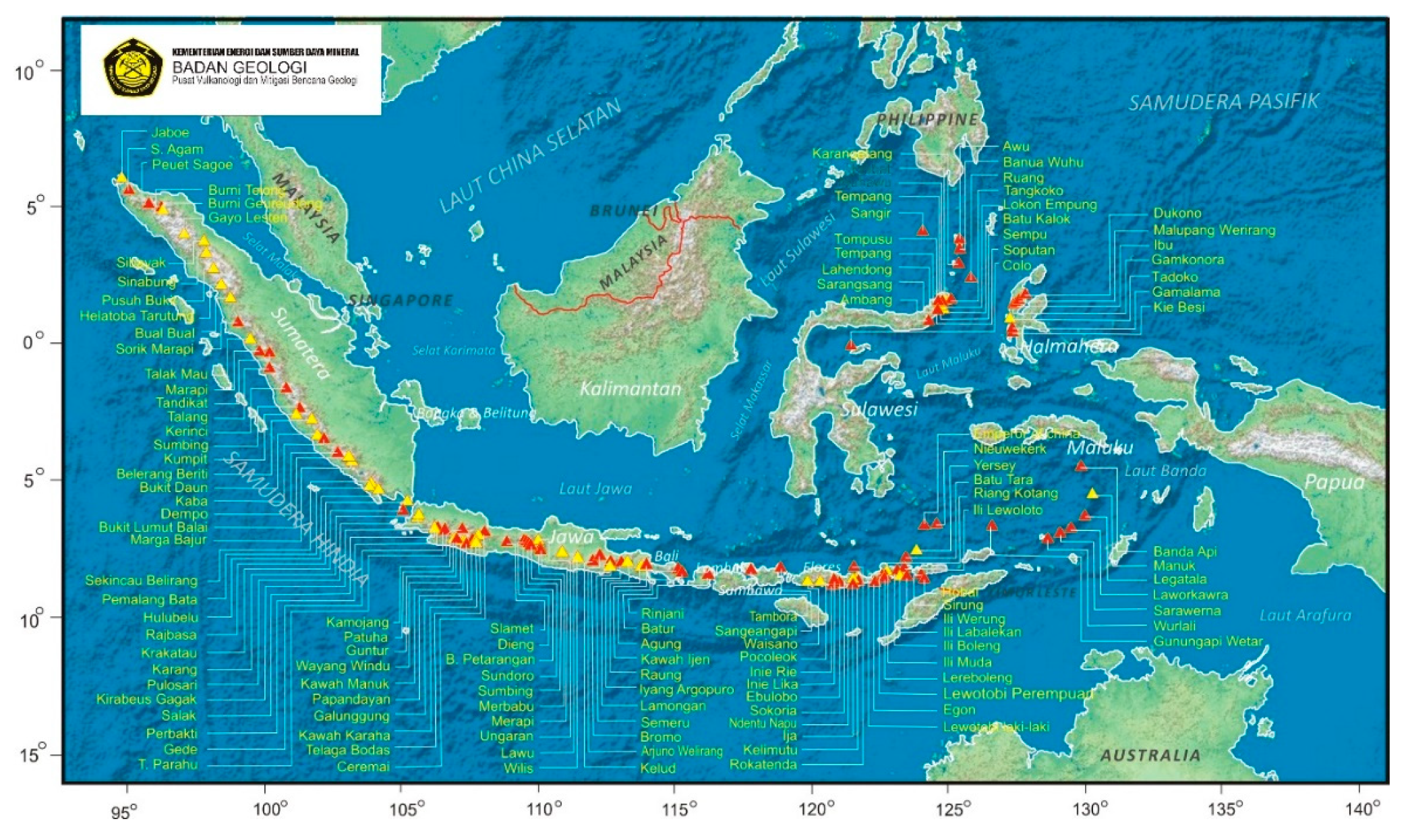
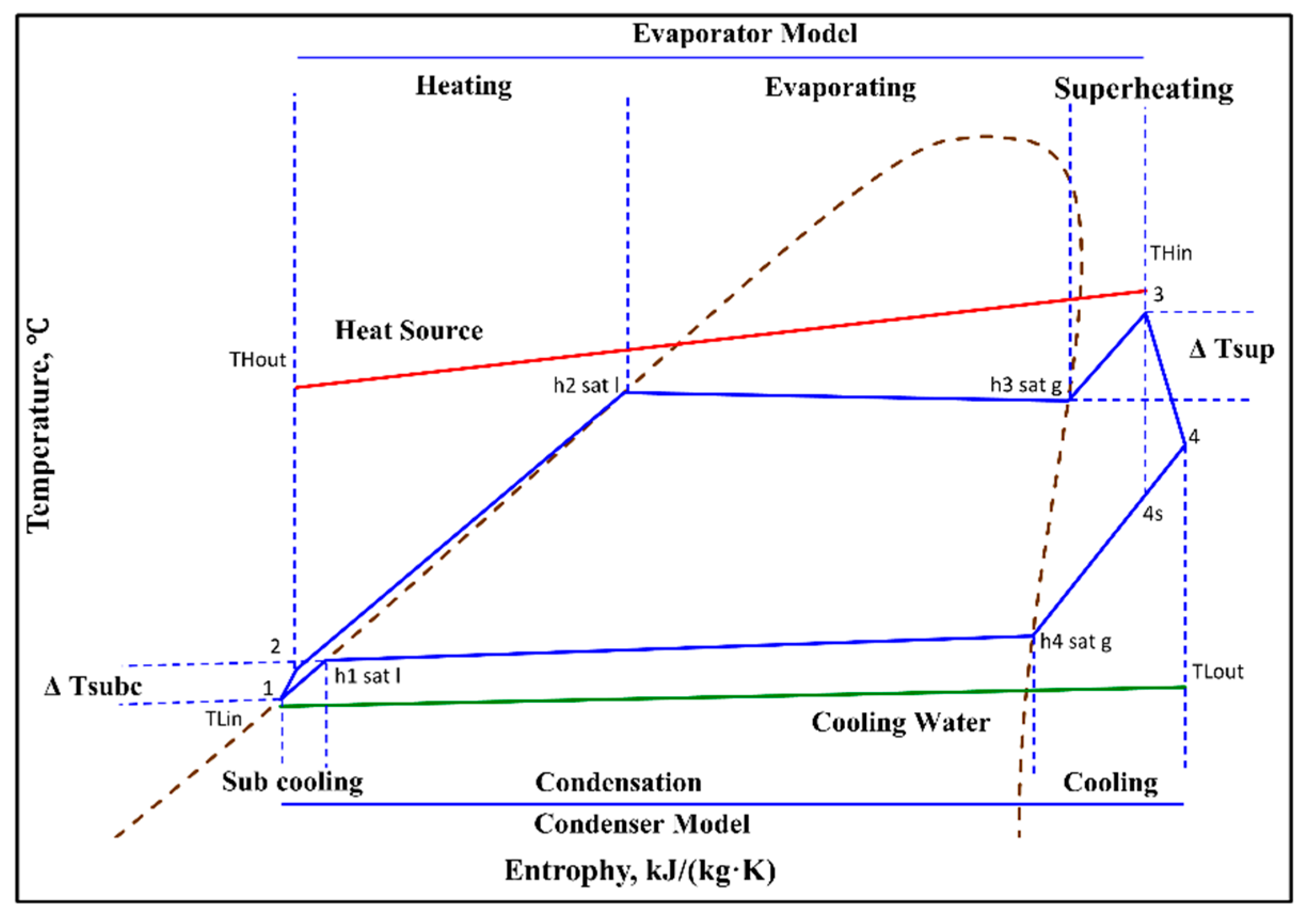
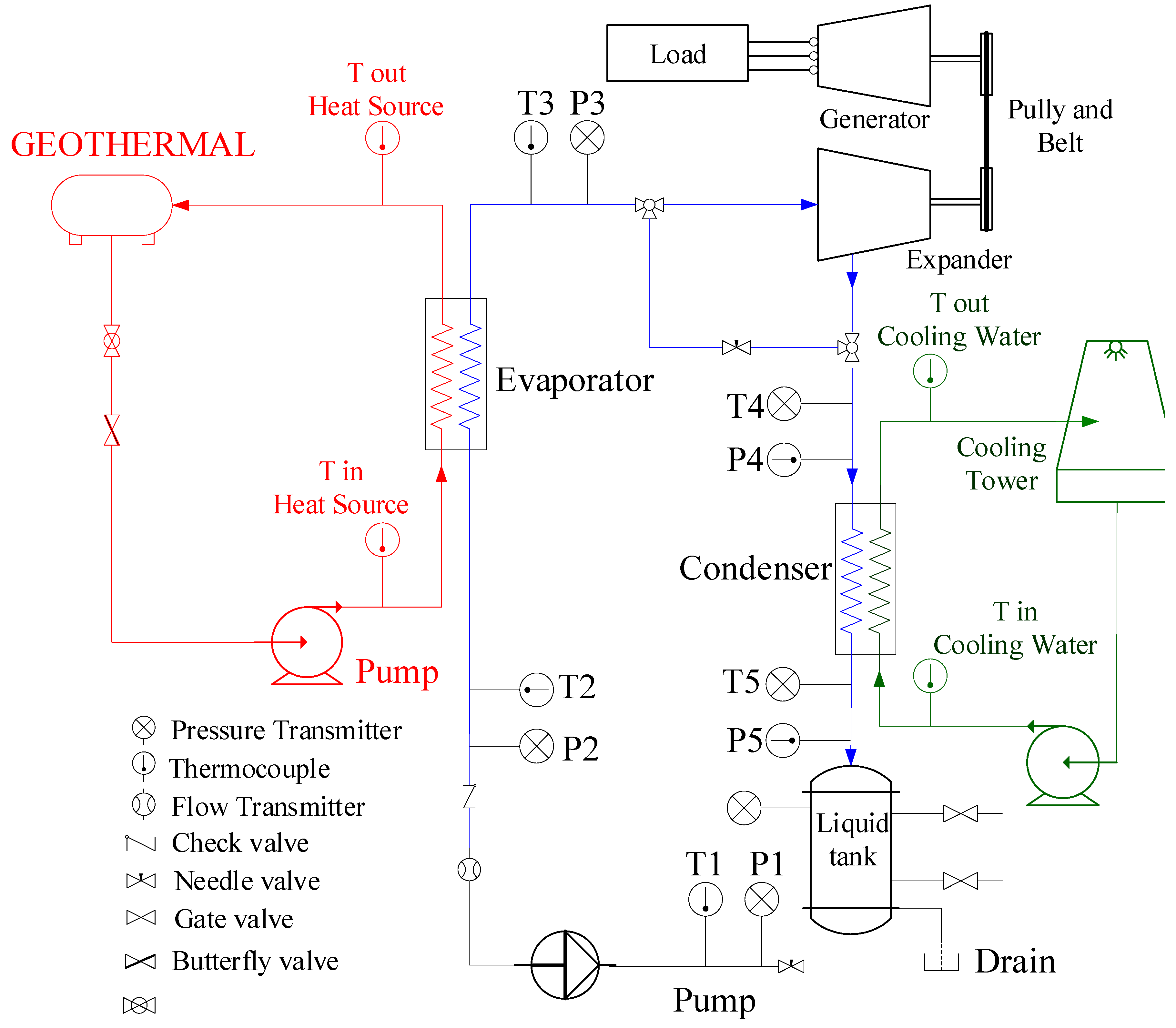
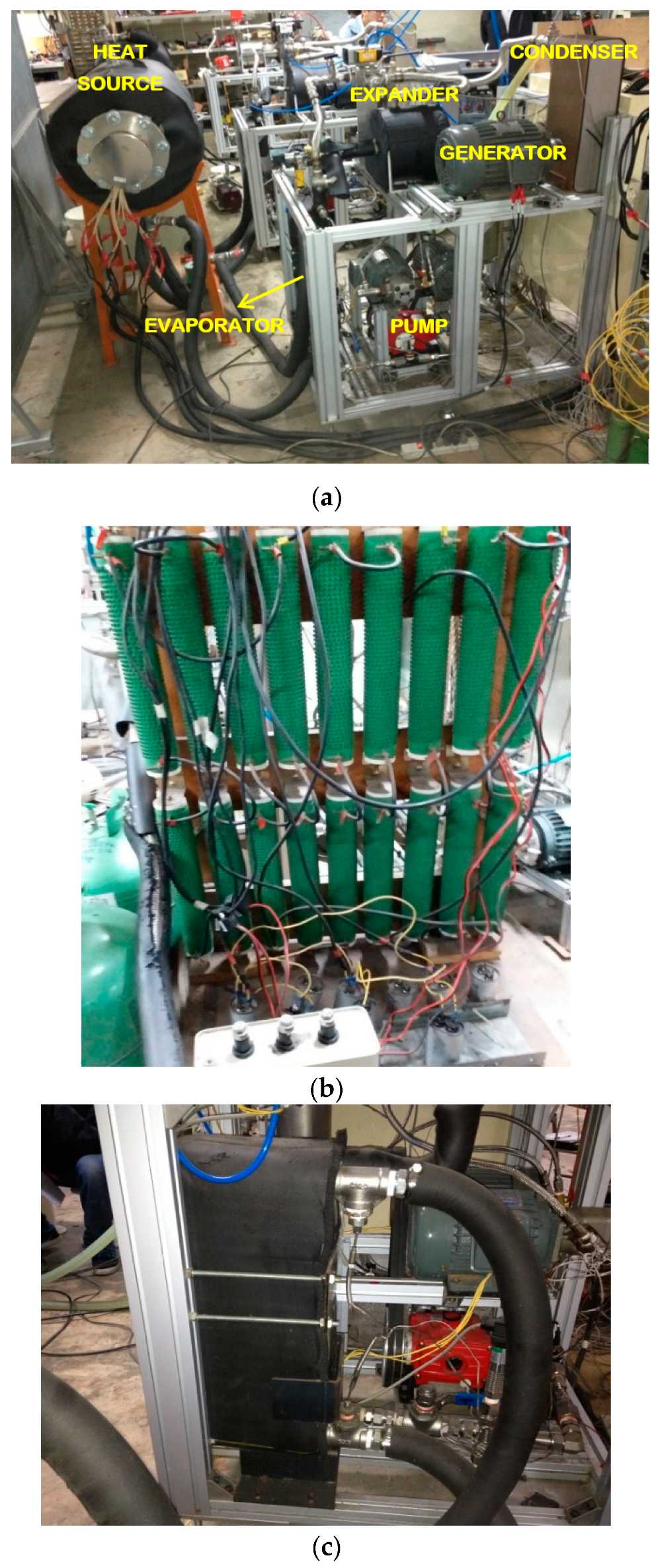
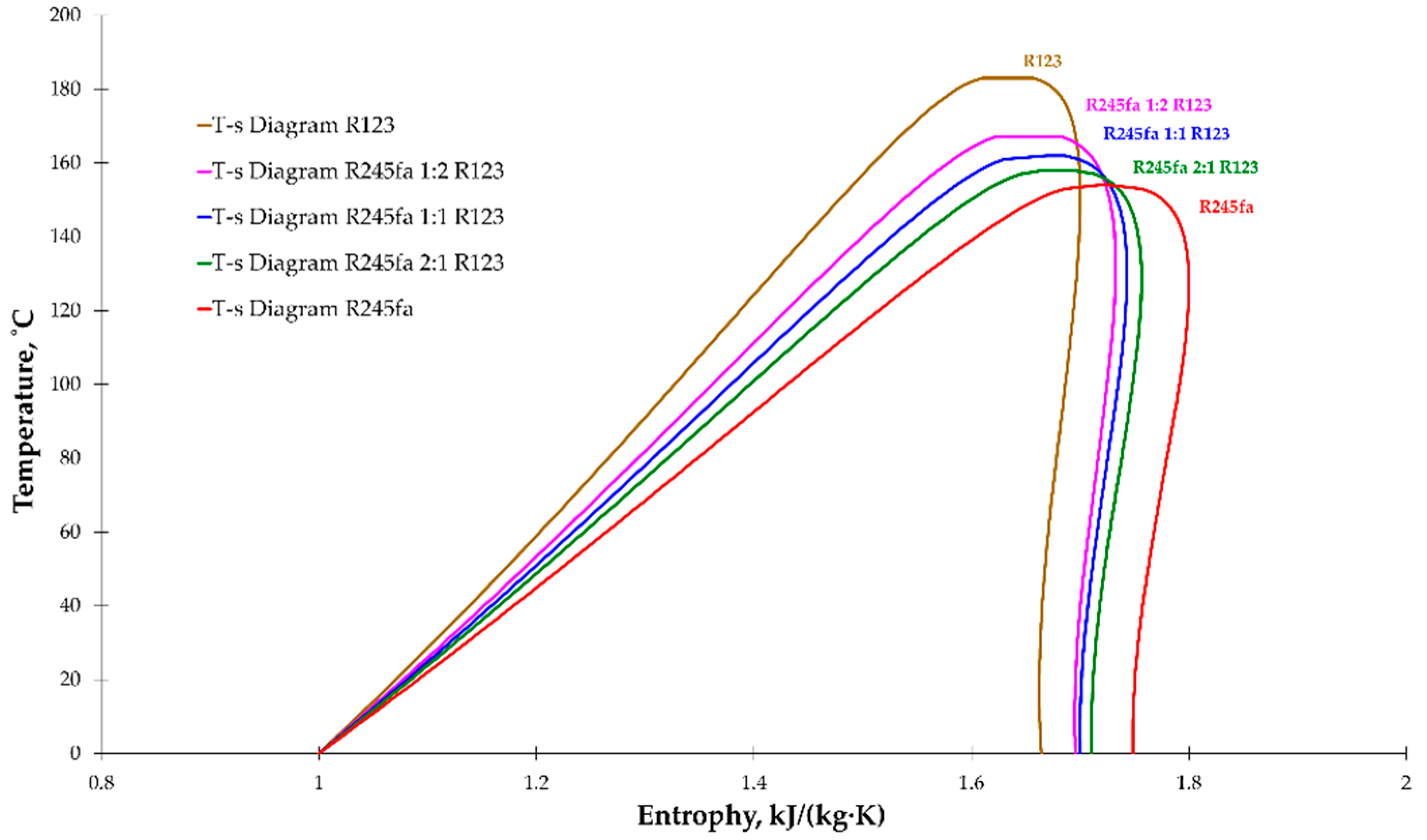
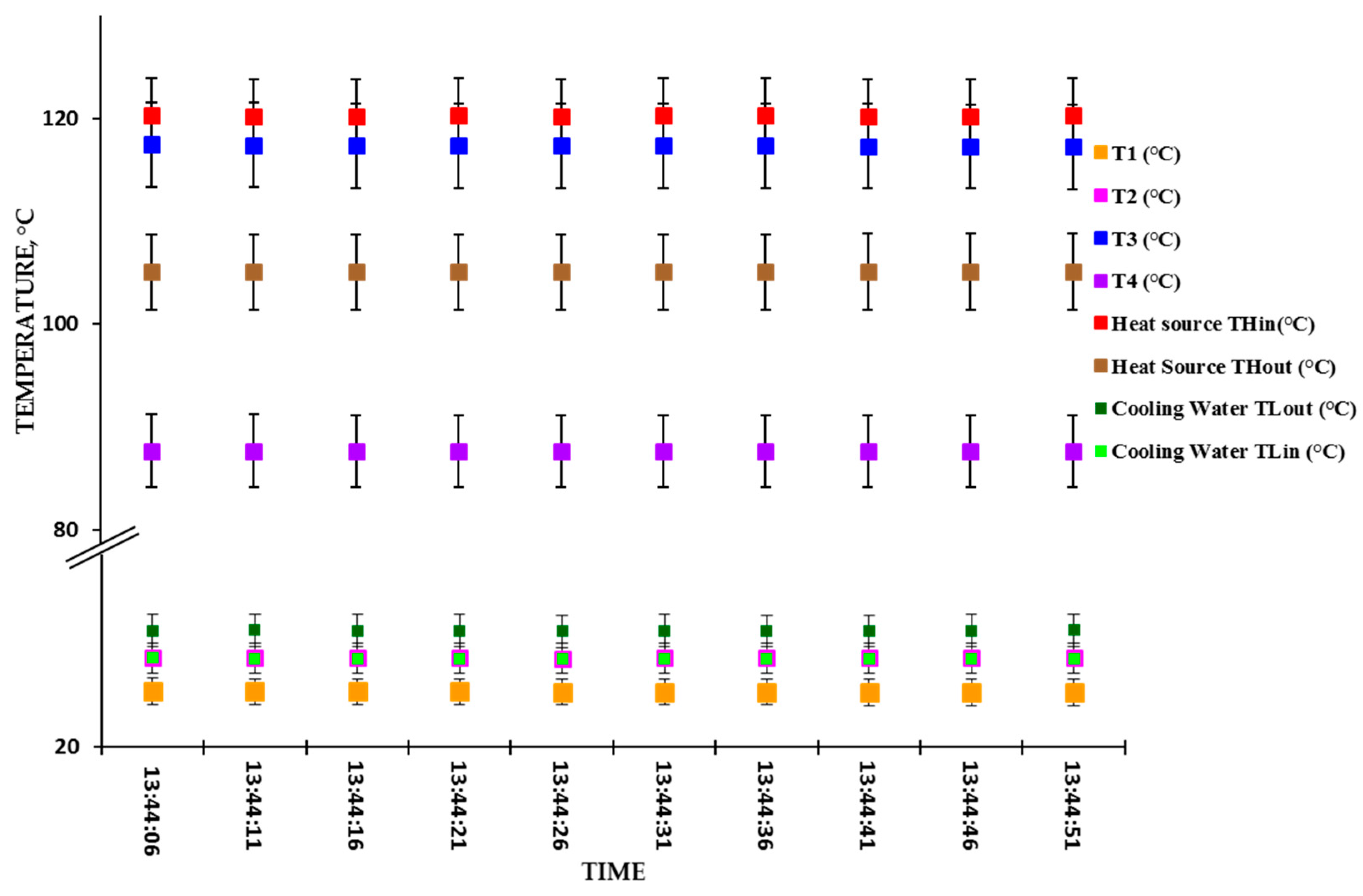
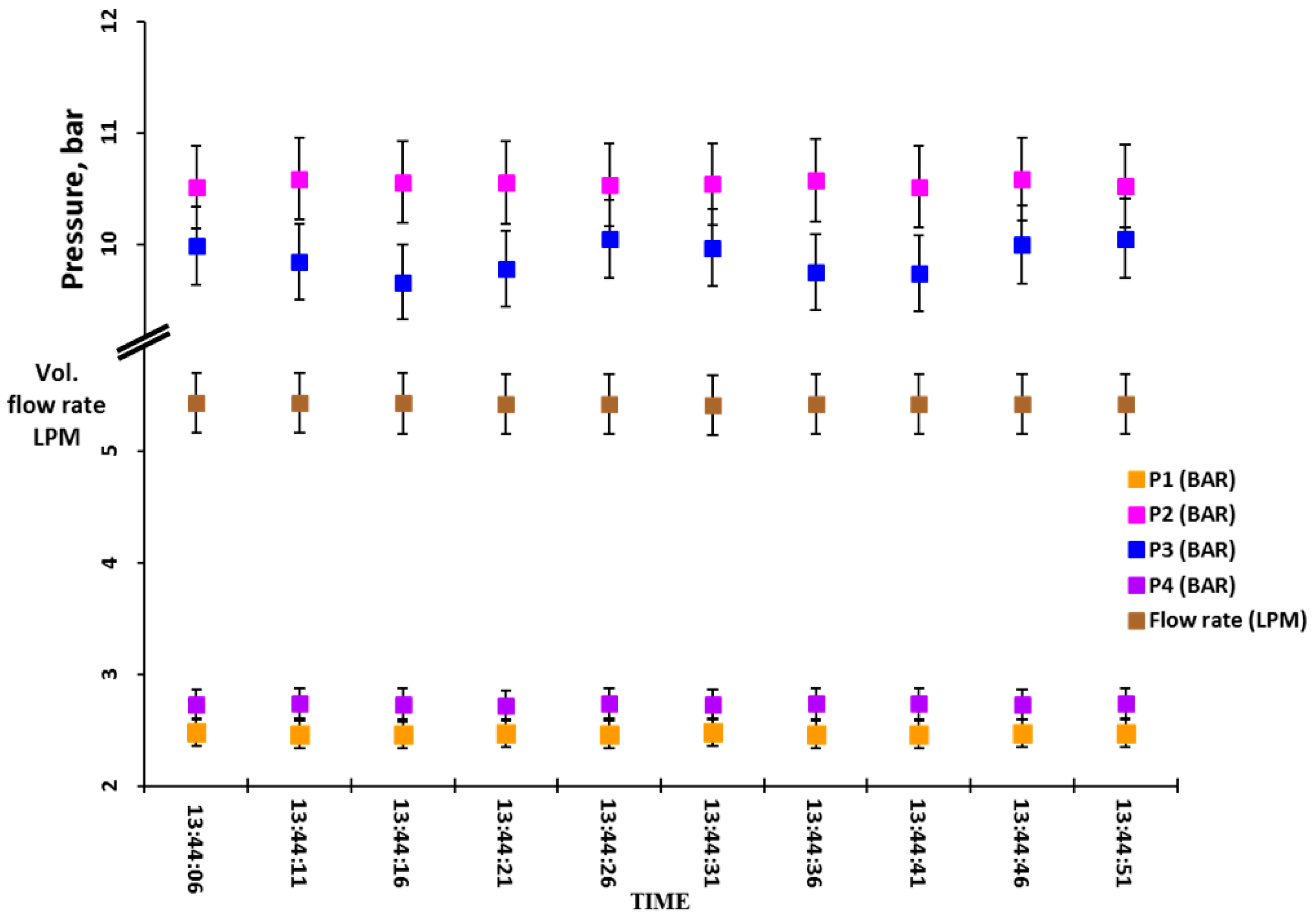
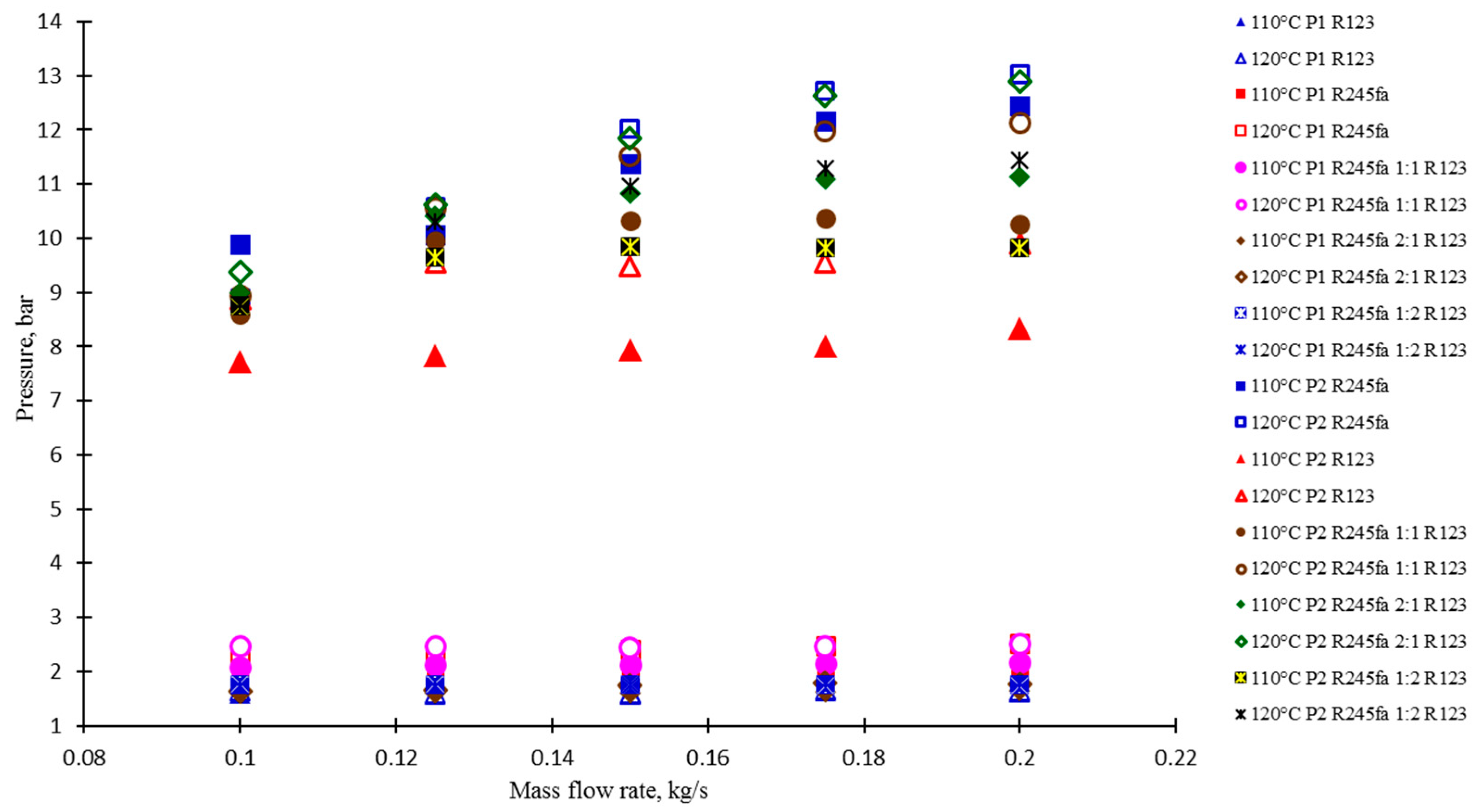
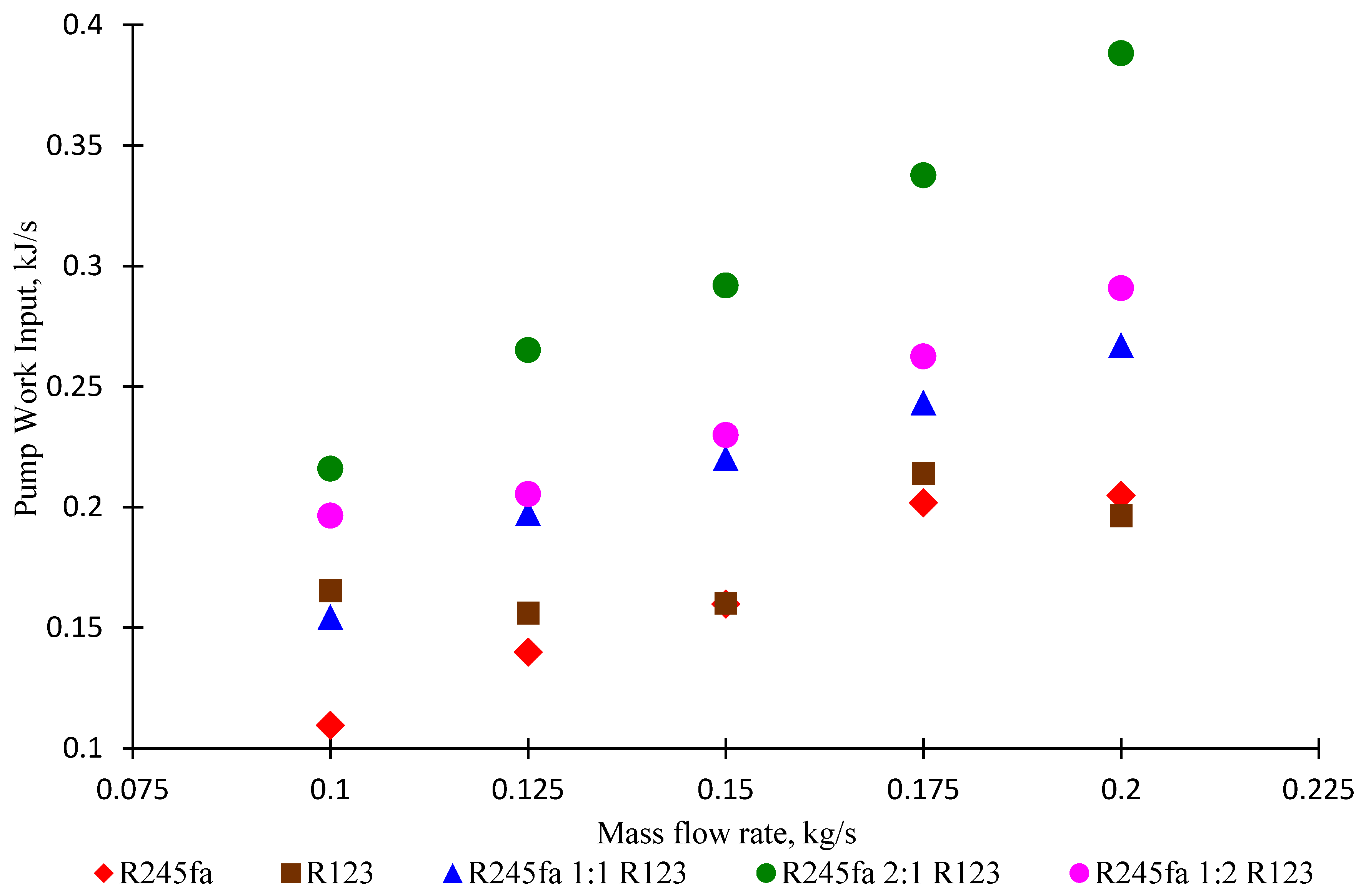
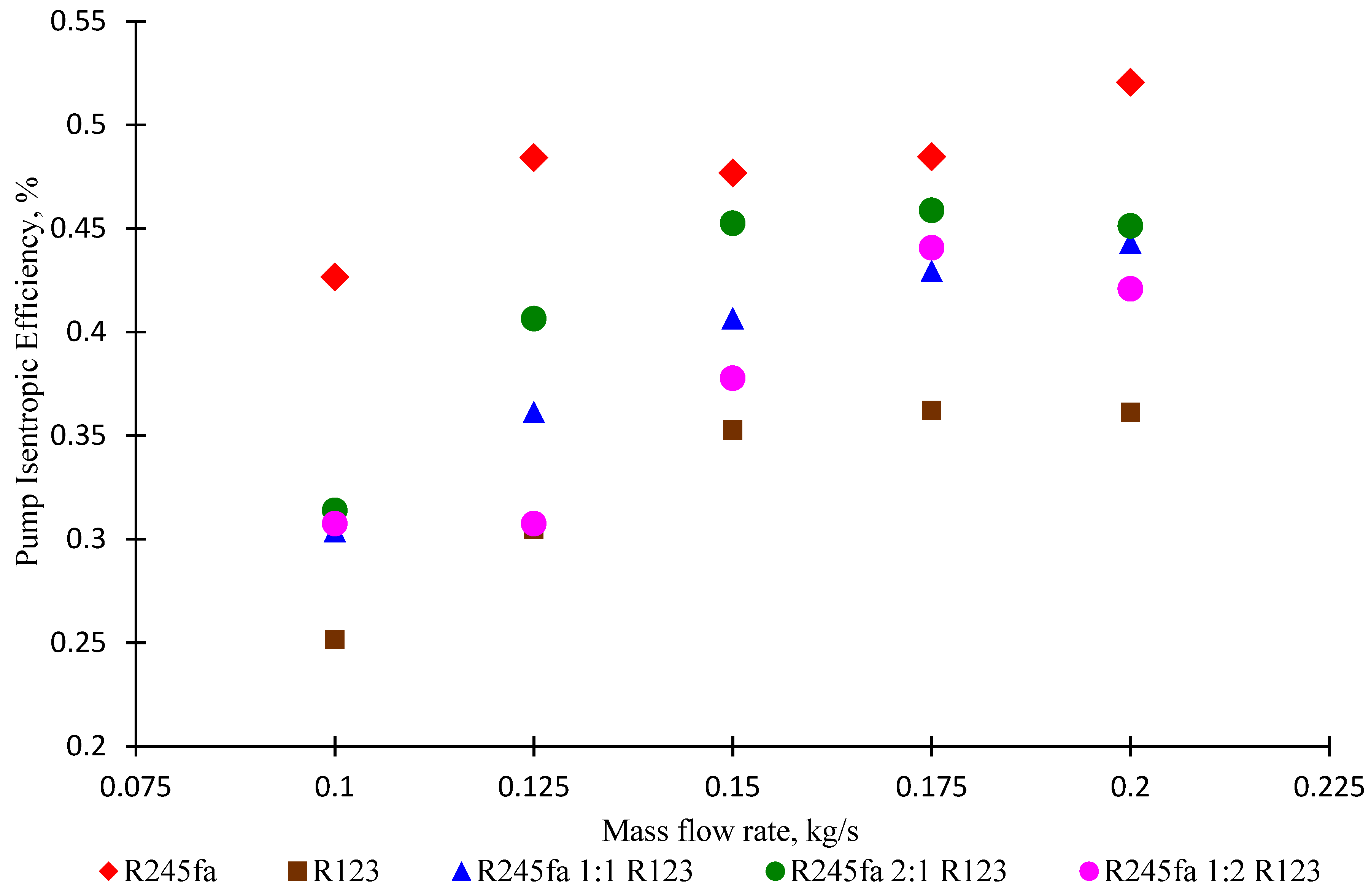
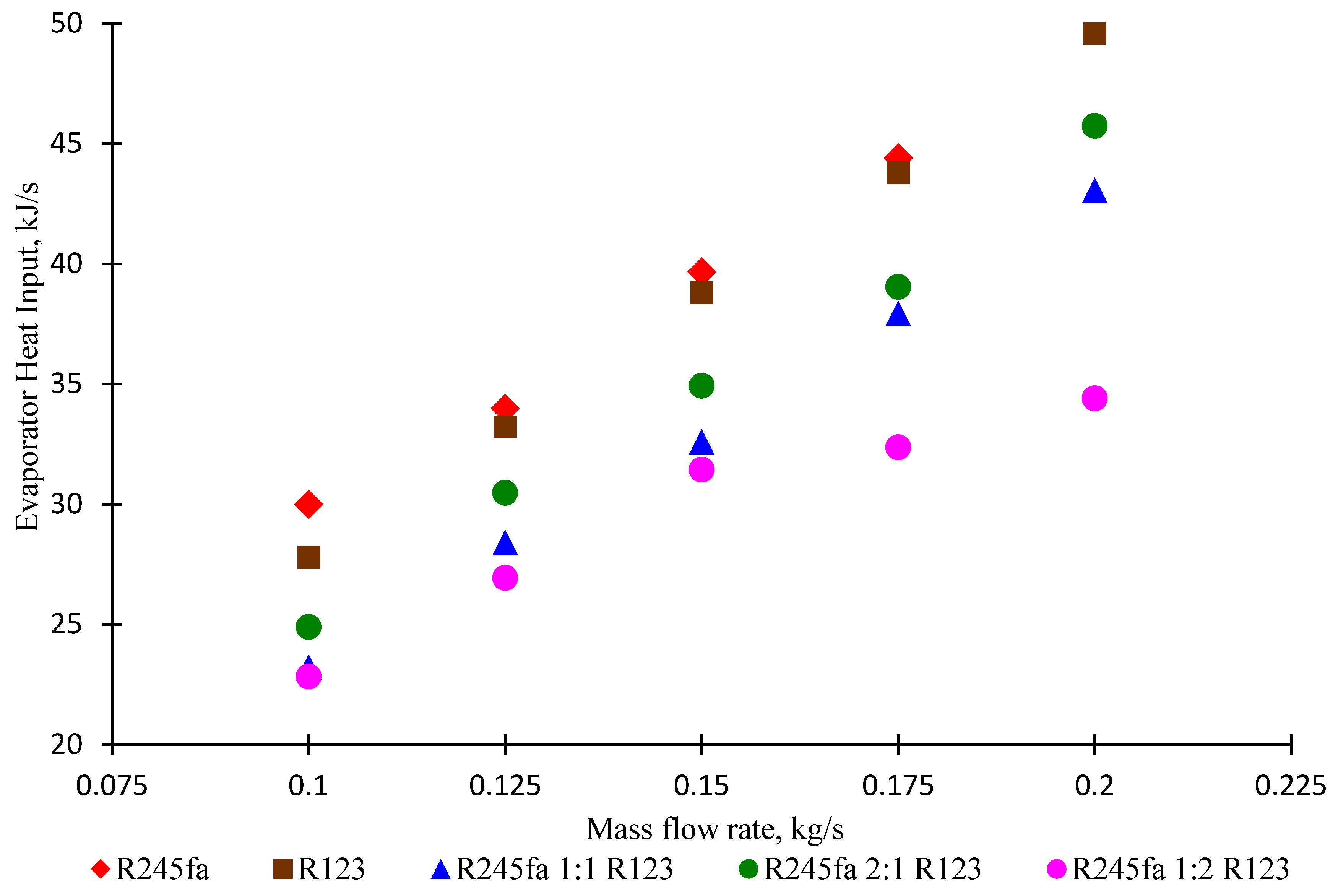
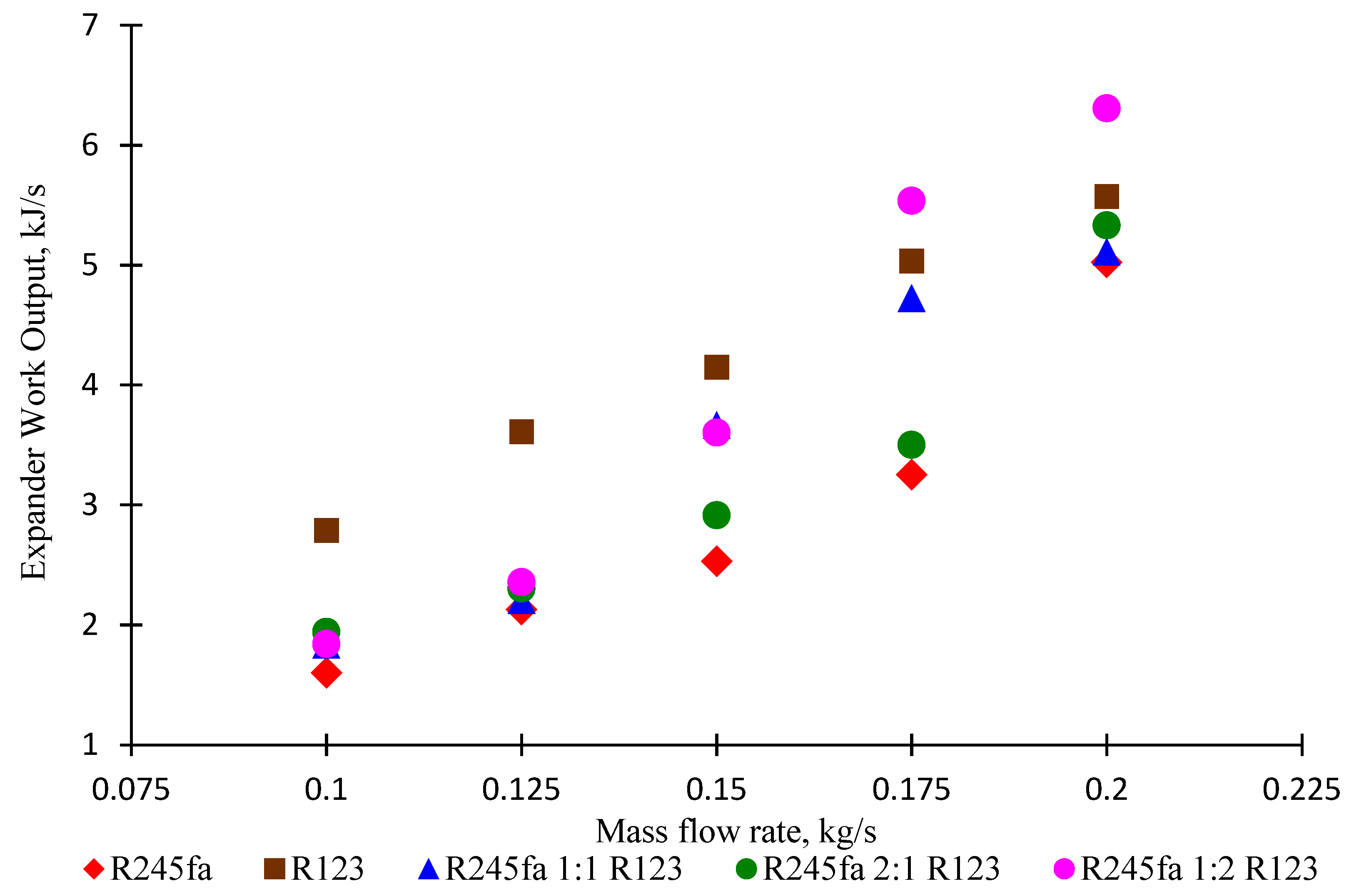
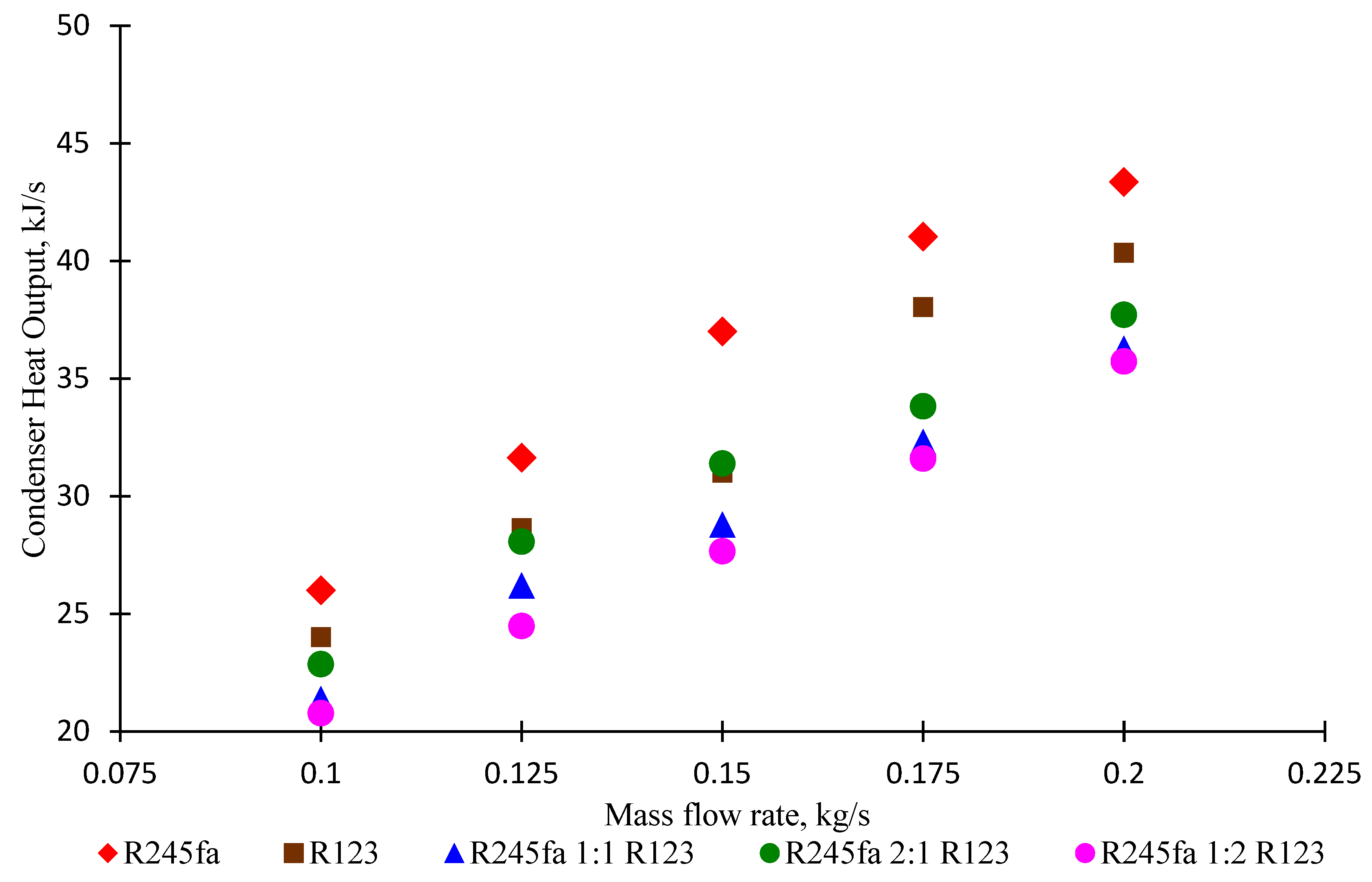
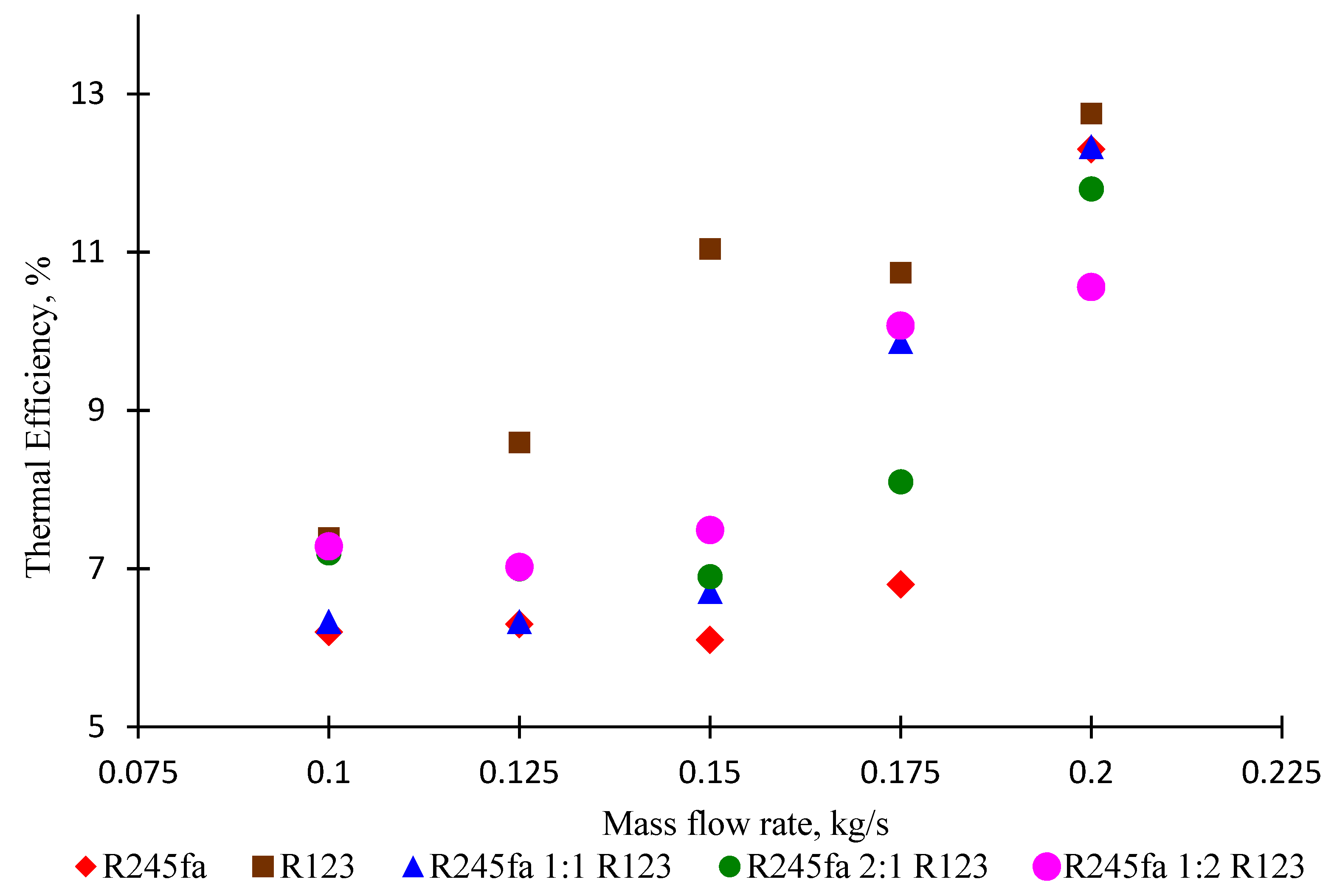
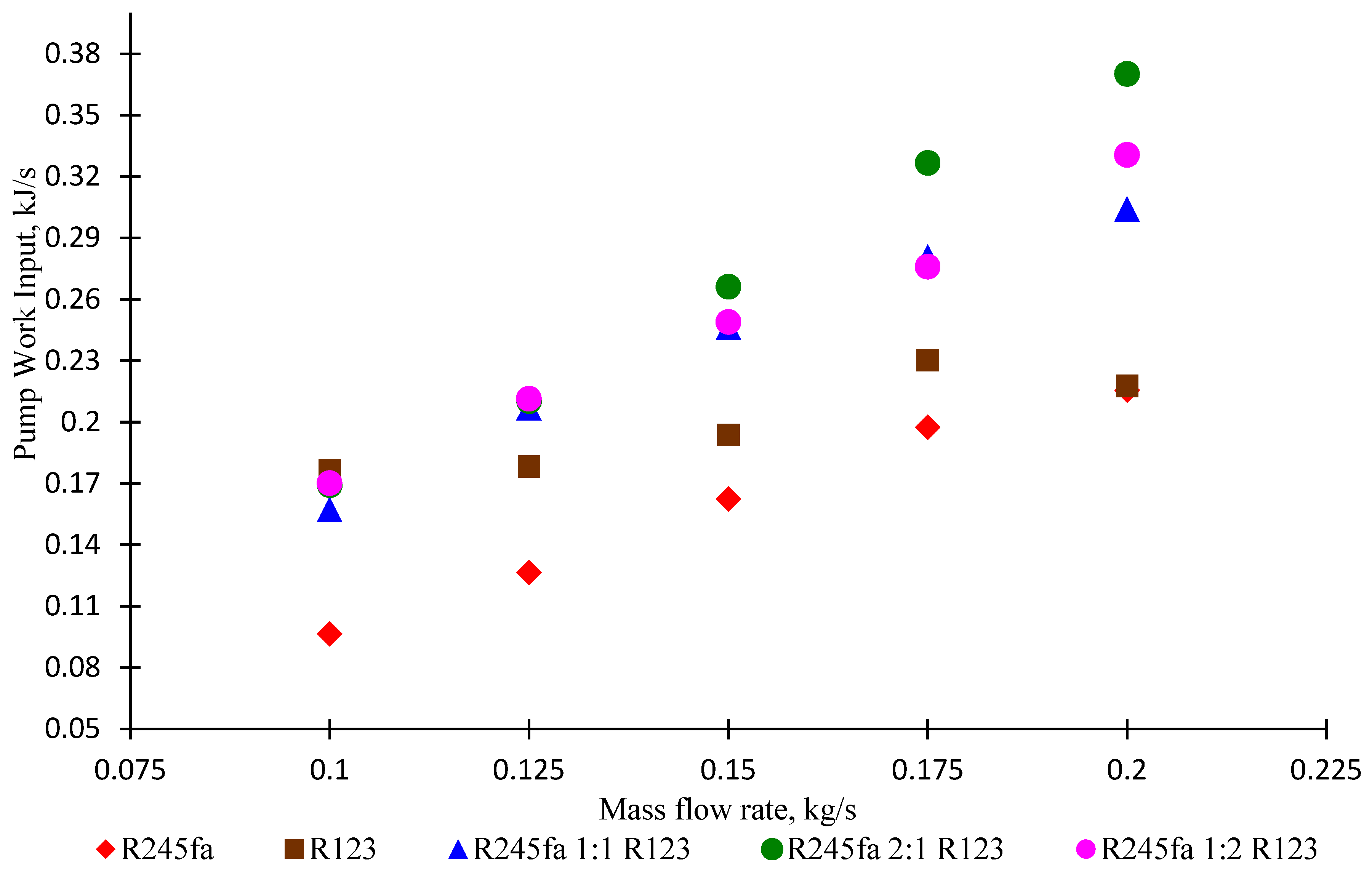
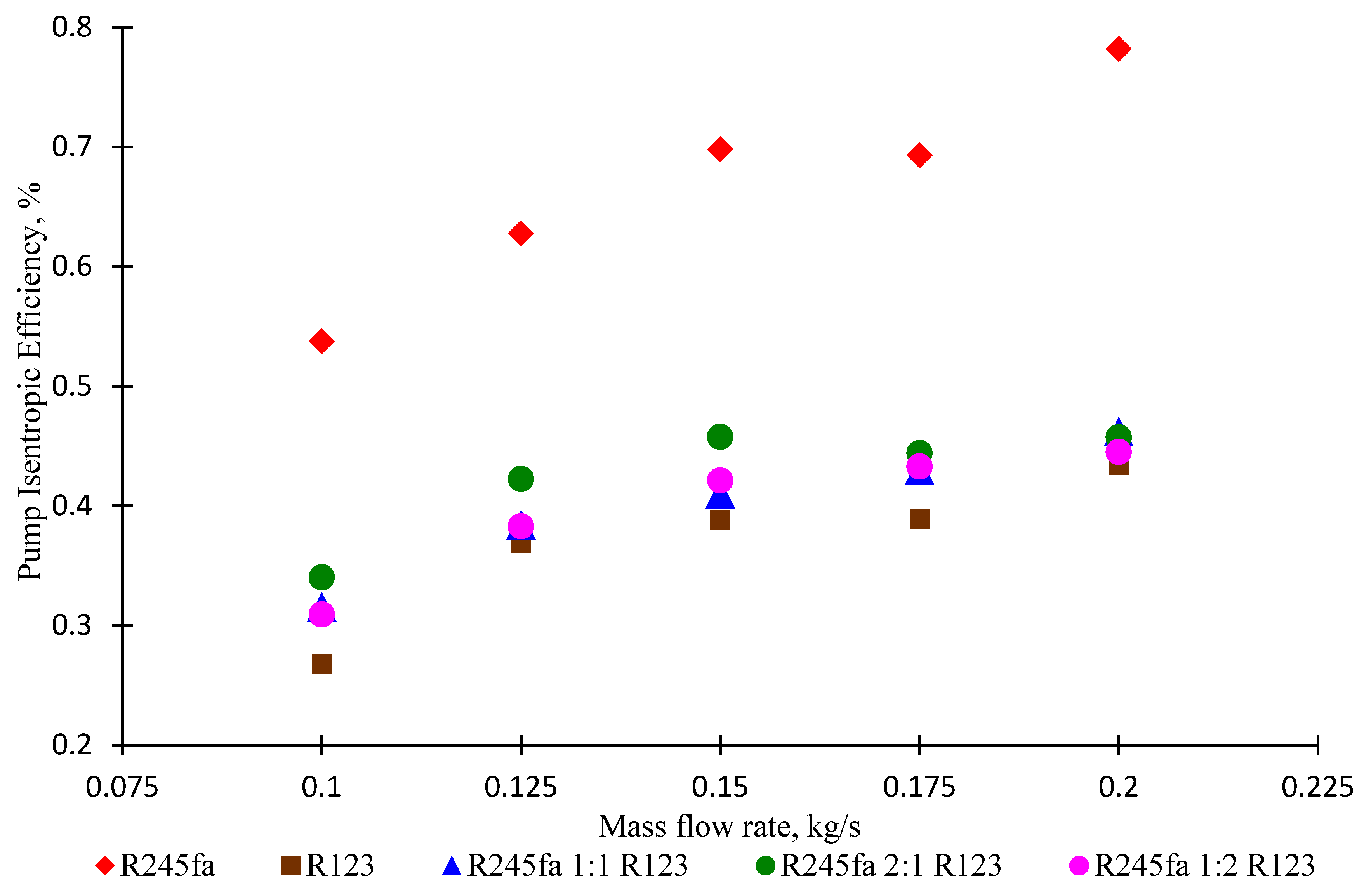
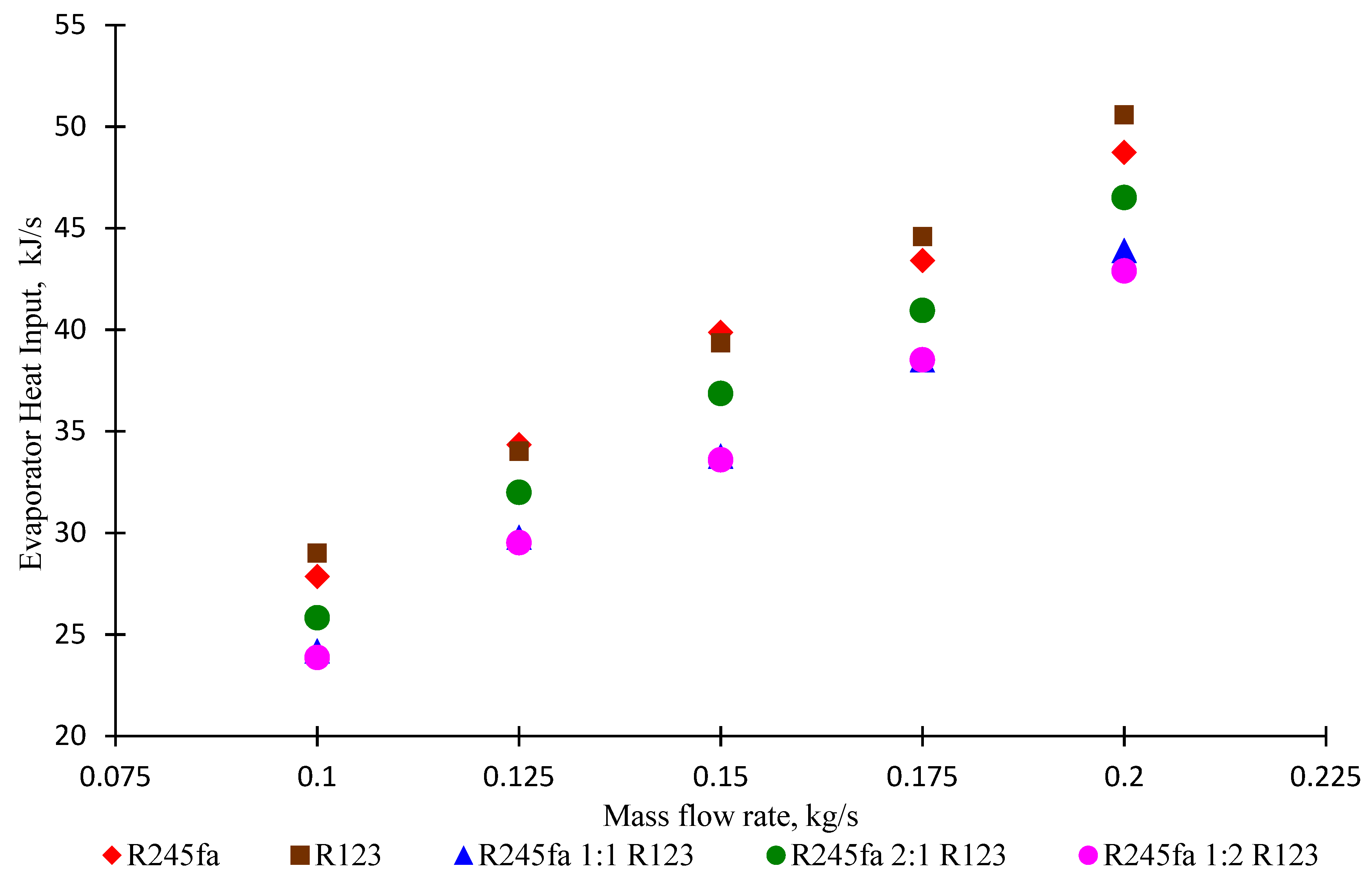
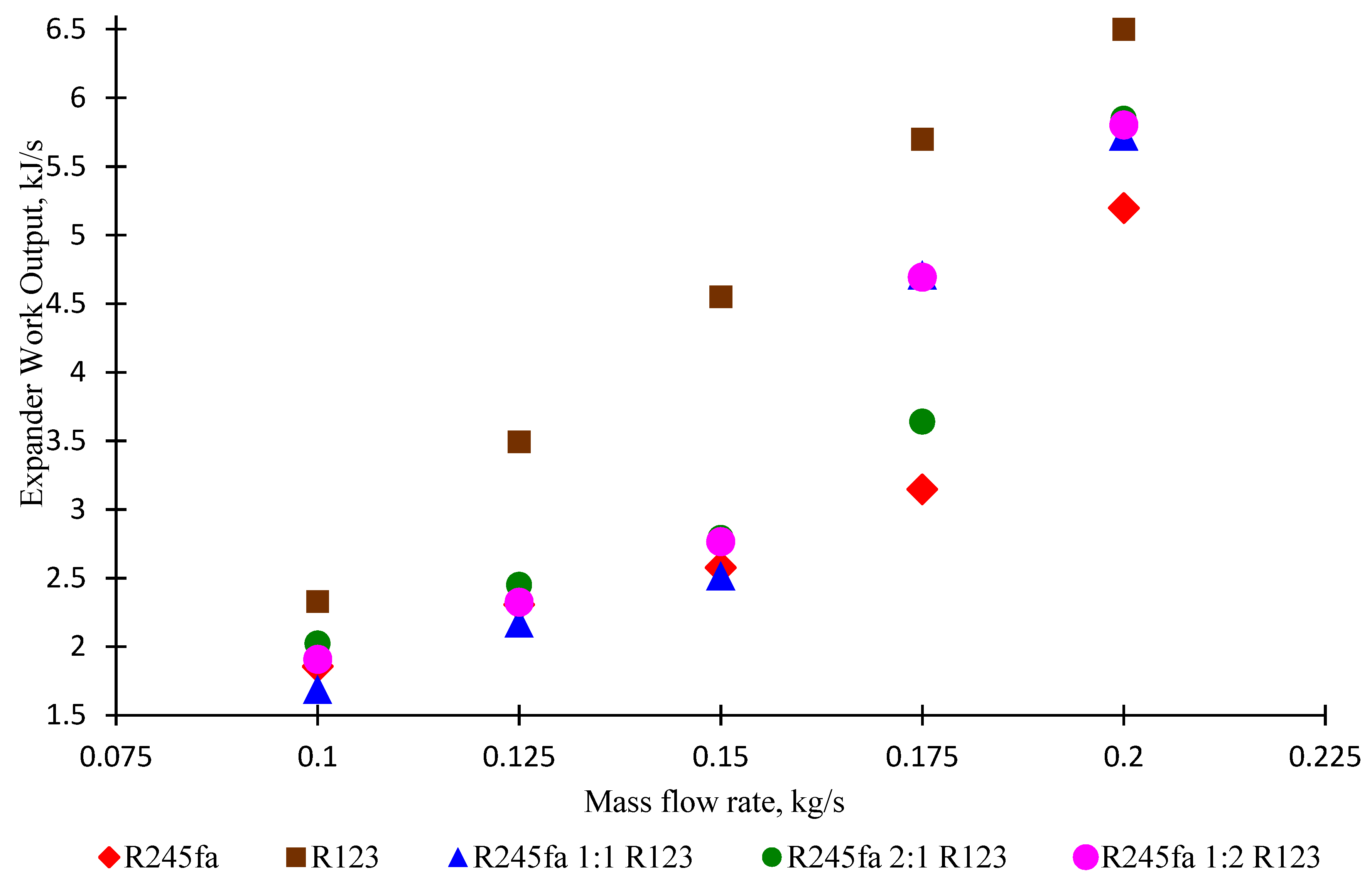
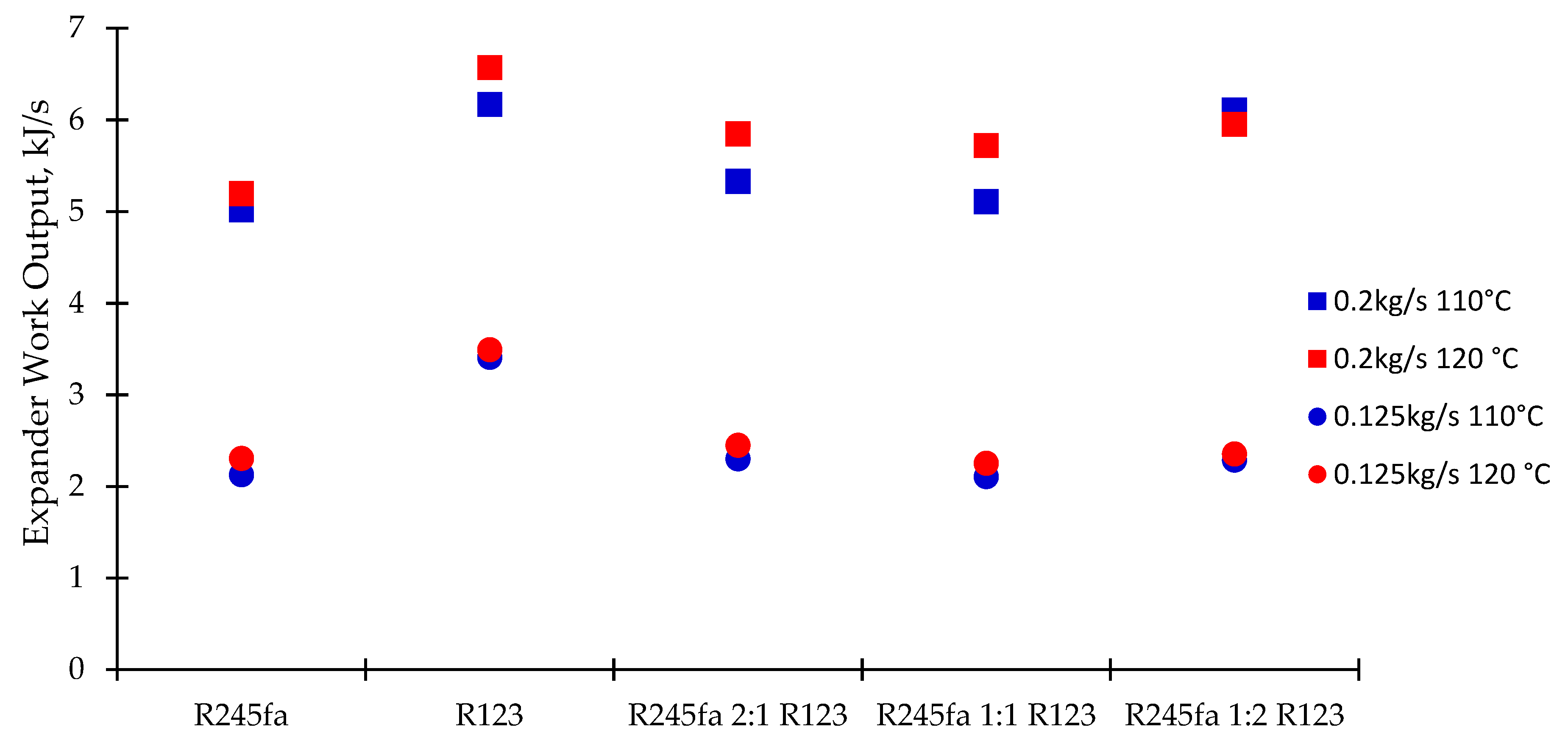
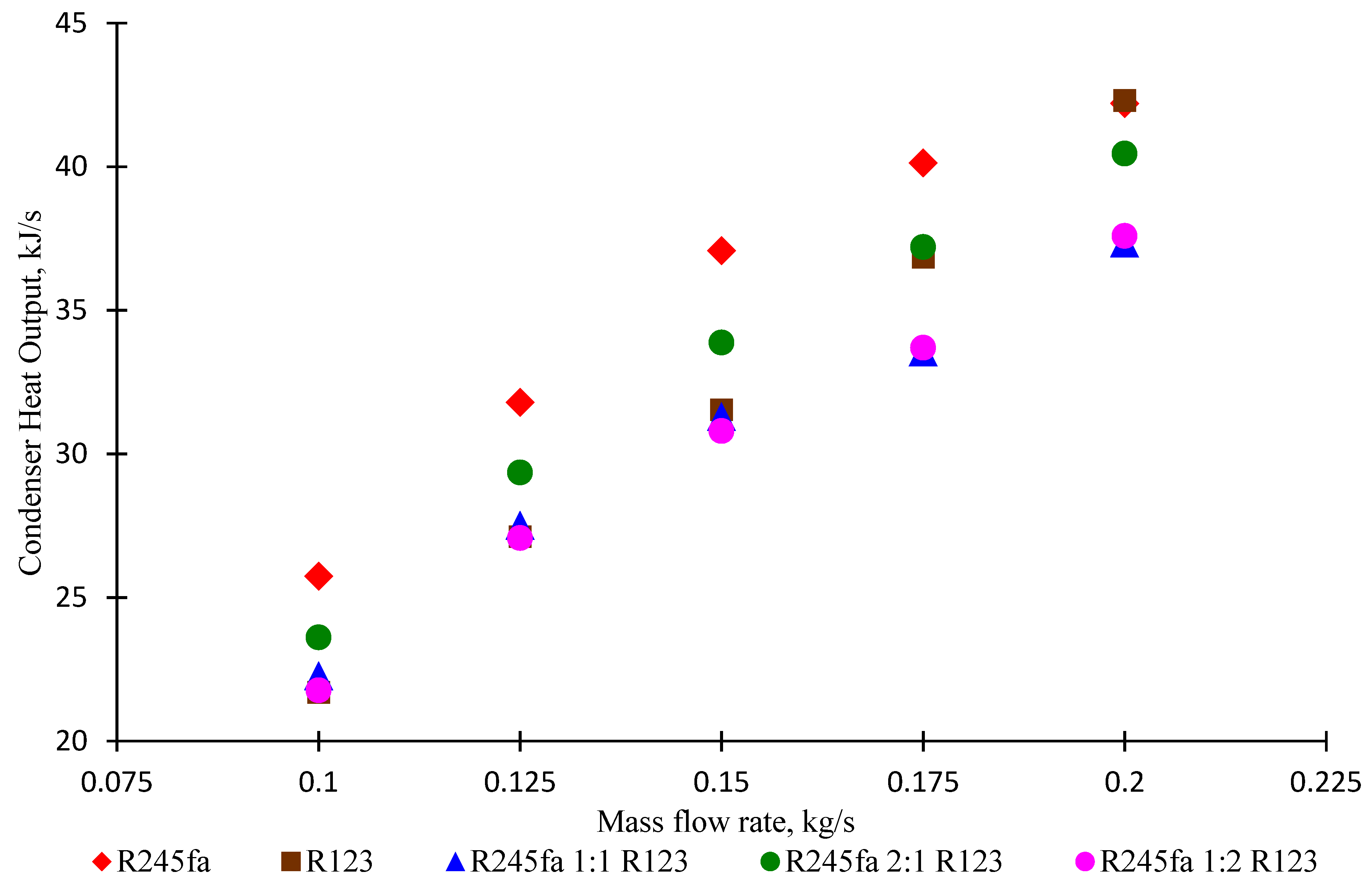
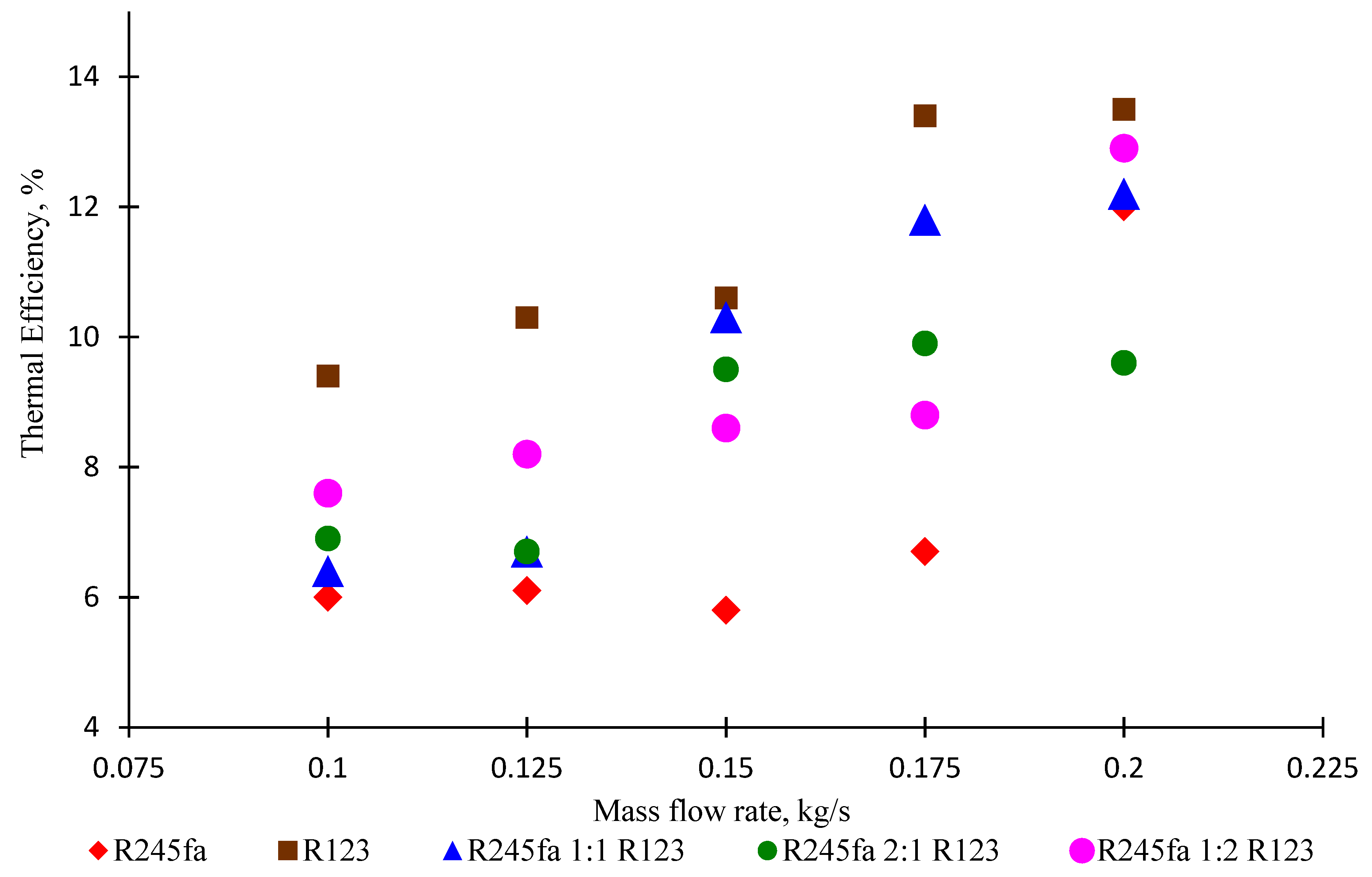
| No | Measuring Instrument | Type | Range | Accuracy |
|---|---|---|---|---|
| 1 | Pressure transmitter (Jetec Electronics Co., Ltd., Taichung, Taiwan) | JPT-131S | 0–30 bar | ±0.5% P.S |
| 2 | Temperature (Deange Industry Co., Ltd., New Taipei, Taiwan) | T-type | 0–623.15 °K | ±0.3 °C |
| 3 | Flowmeter (Great Plains Industries, Sydney, Australia) | GPI S050 | 1.9–37.9 L/min | ±0.3% L/min |
| 4 | Rotation meter (Uni-Trend Technology (Dongguan) Limited, Dongguan, China) | UT-372 | 10–99,999 rpm | ±0.3% rpm |
| 5 | Power meter (Arch Meter Corporation, Hsinchu, Taiwan) | PA310 | V (0–300 VAC), 1 (0–400 A) Hz (50/60 Hz), PF(−1–1) | ±0.5% |
| No | Year | Researcher | Working Fluid | Expander Type |
|---|---|---|---|---|
| 1 | 2018 | Jiang et al. [49] | R123 | - |
| 2 | 2017 | Feng et al. [50] | R123 | Scroll expander |
| 3 | 2017 | Yang et al. [51] | R245fa | Scroll expander |
| 4 | 2017 | Shao et al. [52] | R123 | Radial turbine |
| 5 | 2017 | Feng et al. [53] | R245fa | Scroll expander |
| 6 | 2016 | Eyerer [54] | R245fa | Scroll expander |
| 7 | 2016 | Shu et al. [55] | R123 & R245fa | Expansion valve |
| 8 | 2015 | Chang et al. [56] | R245fa | Scroll expander |
| 9 | 2014 | Chang et al. [57] | R245fa | Scroll expander |
| 10 | 2013 | Li et al. [58] | R123 | Axial flow turbine |
| 11 | 2012 | Shu et al. [59] | R123 | Turbine expander |
| Working Fluid | R245fa | R245fa 2:1 R123 | R245fa 1:1 R123 | R245fa 1:2 R123 | R123 |
|---|---|---|---|---|---|
| Type | Dry | Dry | Dry | Dry | Dry |
| Formula | CHCl2CF3 | - | - | - | CF2CH2CHF2 |
| Molecular mass (g/mol) | 134.03 | 139.8 | 142.87 | 146.07 | 152.93 |
| Freezing point (°C) | <−107 | - | −107 | ||
| Critical Temperature | 154 | 158,19 | 162.5 | 167.9 | 183.8 |
| Critical pressure | 36.504 | 36.435 | 36.638 | 36.59 | 36.6 |
| Density (kg/m3) | 537.03 | 568.11 | 550.07 | 510.09 | 550 |
| Ozone Depletion Potential (ODP) | 0 | - | - | - | 0.02 |
| Global Warming Potential (GWP) | 950–1030 | - | - | - | 77 |
| Inflammability | nonflammable | - | - | - | nonflammable |
| Vapor Viscosity | 10.3 cP | - | - | - | 0.011 cP |
| Liquid Viscosity | 402.7 cP | - | - | - | 0.456 cP |
| Vapor Specific Heat | 0.89 kJ/(kg·K) | - | - | - | 0.72 kJ/(kg·K) |
| Liquid Specific Heat | 1.36 kJ/kg | - | - | - | 0.965 kJ/(kg·K) |
| Liquid Thermal Conductivity | 0.081 W/(m·K) | - | - | - | 0.096 W/(m·K) |
| R245fa | R123 | R245fa 2:1 R123 | R245fa 1:1 R123 | R245fa 1:2 R123 |
|---|---|---|---|---|
| kg/s | kg/s | kg/s | kg/s | kg/s |
| 3.51 | 7.55 | 3.52 | 3.23 | 3.66 |
| 3.45 | 8.27 | 3.72 | 3.68 | 3.74 |
| 3.51 | 9.39 | 3.65 | 3.48 | 3.97 |
| 3.60 | 10.05 | 3.89 | 4.05 | 4.37 |
| 3.95 | 10.30 | 4.28 | 4.55 | 4.81 |
| R245fa | R123 | R245fa 1:1 R123 | R245fa 2:1 R123 | R245fa 1:2 R123 | ||||||||||
|---|---|---|---|---|---|---|---|---|---|---|---|---|---|---|
| Cold Water Inlet | Cold Water Outlet | Flow Rate | Cold Water Inlet | Cold Water Outlet | Flow Rate | Cold Water Inlet | Cold Water Outlet | Flow Rate | Cold Water Inlet | Cold Water Outlet | Flow Rate | Cold Water Inlet | Cold Water Outlet | Flow Rate |
| °C | °C | Kg/s | °C | °C | Kg/s | °C | °C | Kg/s | °C | °C | Kg/s | °C | °C | Kg/s |
| 27.67 | 30.55 | 2.14 | 25.65 | 27.96 | 2.12 | 30.21 | 30.25 | 2.48 | 19.28 | 21.61 | 2.43 | 25.04 | 27.04 | 2.61 |
| 28.46 | 32.04 | 2.12 | 16.27 | 18.27 | 3.17 | 28.50 | 31.20 | 2.44 | 19.96 | 22.82 | 2.46 | 25.35 | 27.89 | 2.55 |
| 28.85 | 33.01 | 2.13 | 16.25 | 18.54 | 3.12 | 28.29 | 31.02 | 2.74 | 21.50 | 24.78 | 2.47 | 25.63 | 28.45 | 2.61 |
| 29.06 | 33.52 | 2.15 | 16.33 | 18.70 | 3.04 | 28.31 | 31.15 | 2.83 | 21.57 | 25.03 | 2.58 | 25.66 | 28.60 | 2.74 |
| 29.11 | 33.70 | 2.20 | 18.42 | 20.97 | 3.00 | 28.37 | 31.35 | 2.99 | 21.09 | 24.66 | 2.71 | 25.66 | 28.63 | 3.03 |
© 2019 by the authors. Licensee MDPI, Basel, Switzerland. This article is an open access article distributed under the terms and conditions of the Creative Commons Attribution (CC BY) license (http://creativecommons.org/licenses/by/4.0/).
Share and Cite
Surindra, M.D.; Caesarendra, W.; Prasetyo, T.; Mahlia, T.M.I.; Taufik. Comparison of the Utilization of 110 °C and 120 °C Heat Sources in a Geothermal Energy System Using Organic Rankine Cycle (ORC) with R245fa, R123, and Mixed-Ratio Fluids as Working Fluids. Processes 2019, 7, 113. https://doi.org/10.3390/pr7020113
Surindra MD, Caesarendra W, Prasetyo T, Mahlia TMI, Taufik. Comparison of the Utilization of 110 °C and 120 °C Heat Sources in a Geothermal Energy System Using Organic Rankine Cycle (ORC) with R245fa, R123, and Mixed-Ratio Fluids as Working Fluids. Processes. 2019; 7(2):113. https://doi.org/10.3390/pr7020113
Chicago/Turabian StyleSurindra, Mochamad Denny, Wahyu Caesarendra, Totok Prasetyo, Teuku Meurah Indra Mahlia, and Taufik. 2019. "Comparison of the Utilization of 110 °C and 120 °C Heat Sources in a Geothermal Energy System Using Organic Rankine Cycle (ORC) with R245fa, R123, and Mixed-Ratio Fluids as Working Fluids" Processes 7, no. 2: 113. https://doi.org/10.3390/pr7020113
APA StyleSurindra, M. D., Caesarendra, W., Prasetyo, T., Mahlia, T. M. I., & Taufik. (2019). Comparison of the Utilization of 110 °C and 120 °C Heat Sources in a Geothermal Energy System Using Organic Rankine Cycle (ORC) with R245fa, R123, and Mixed-Ratio Fluids as Working Fluids. Processes, 7(2), 113. https://doi.org/10.3390/pr7020113







